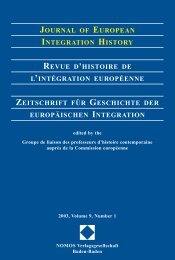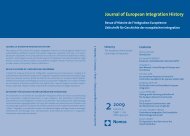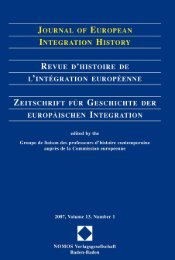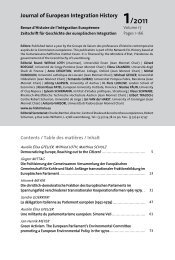journal of european integration history revue d'histoire de l ...
journal of european integration history revue d'histoire de l ...
journal of european integration history revue d'histoire de l ...
Create successful ePaper yourself
Turn your PDF publications into a flip-book with our unique Google optimized e-Paper software.
20<br />
Maurice FitzGerald<br />
it has been argued here that this was not an exclusive or pre<strong>de</strong>stined phenomenon;<br />
in<strong>de</strong>ed, Ireland’s singularity might have as readily been interpreted as being as<br />
troublesome as it was appealing. The reality <strong>of</strong> this position begs an obvious question:<br />
why was Ireland allowed to join? Whitaker argued in 1962 that “nobody so<br />
loves us as to want us in the EEC on our own terms”. 40 In<strong>de</strong>ed, why did it thus<br />
become the first peripheral to acce<strong>de</strong>?<br />
The role external and internal influences played cannot be un<strong>de</strong>restimated. During<br />
the course <strong>of</strong> the 1960s, the Irish government worked very hard to make its case<br />
for membership convincing. However, it was not just a case <strong>of</strong> Ireland looking to<br />
Europe, as it was also paying full attention to matters closer to home and across the<br />
Irish Sea. As Roy Foster <strong>de</strong>clares, it would in<strong>de</strong>ed be “disingenuous” to argue that<br />
the European continent is more influential than Ireland's closest neighbour. 41 So,<br />
who was responsible for this turnaround in Irish fortunes and who or what were<br />
these powerful influences?<br />
Certainly, Ireland would not have contemplated joining without the UK acceding<br />
as well; in reality, it would not have applied in the first place way back in 1961 if the<br />
latter had not indicated that it was about to do the same. It would have been an “economic<br />
disaster” for it to do otherwise. 42 In the intervening period between initially<br />
applying and finally succeeding, the government had constantly been readying itself,<br />
as well as the rest <strong>of</strong> the country, for the uncertain vagaries that full EEC membership<br />
implied, while also readily acknowledging and recognising its real and inherent value.<br />
The effects, especially on industry, but also on agriculture, <strong>of</strong> shifting the Irish<br />
economy from protectionism to liberalisation were to be pr<strong>of</strong>ound.<br />
In signing the AIFTA agreement in 1965, Ireland clearly <strong>de</strong>monstrated that it<br />
could compete on an even economic playing field with the UK, at the same time<br />
showing that bilateral Anglo-Irish political relations had finally matured beyond<br />
pubescence. Dublin was even prepared to take a step backwards towards further <strong>de</strong>pen<strong>de</strong>nce<br />
on the UK in or<strong>de</strong>r to go two steps forward in the direction <strong>of</strong> inter<strong>de</strong>pen<strong>de</strong>nce<br />
with Europe. 43 This was readily recognised by the EEC, while confirming<br />
the view in Brussels that – though it might not have been joining as part <strong>of</strong> some<br />
UK package or ad<strong>de</strong>ndum – Ireland was only now <strong>de</strong>aling with the reality <strong>of</strong> its<br />
40. Whitaker to Jack Lynch (Irish industry & commerce minister), 5 January 1962, NA, D/T,<br />
S16877X/62.<br />
41. R. FOSTER, Paddy and Mr Punch: connections in Irish and English <strong>history</strong>, London, 1993, pp.31-32.<br />
42. Whitaker to Lynch, 5 January 1962, NA, D/T, S16877X/62.<br />
43. As evi<strong>de</strong>nce <strong>of</strong> this, it is possible to point to a consi<strong>de</strong>rable change that took place in Irish trading<br />
patterns. During the years in which Lemass was taoiseach, the average figures for exports to the<br />
UK and the Six were 72.8% and 8.4% respectively; concurrently, import figures became 50.7%<br />
and 14.1%, pro<strong>of</strong> <strong>of</strong> a significant economic reorientation. In fact, this was an ongoing pattern.<br />
Tra<strong>de</strong> with the EEC increased dramatically in the period after its creation was mooted in 1955,<br />
when 4.4% <strong>of</strong> Irish goods went in that direction; on the eve <strong>of</strong> its third set <strong>of</strong> negotiations at the<br />
end <strong>of</strong> the 1960s, it stood at 11.3% <strong>of</strong> exports. In the same period, exports to the UK fell from<br />
89.2% to 65.9%, a significant and ongoing <strong>de</strong>crease. All data comes from <strong>of</strong>ficial figures to be<br />
found in CENTRAL STATISTICS OFFICE, Ireland: tra<strong>de</strong> and shipping statistics, Dublin,<br />
volume published in 1959, pp.5-10; vol.1969, pp.16-17 and 26-27; and vol.1970, pp.14-15.

















